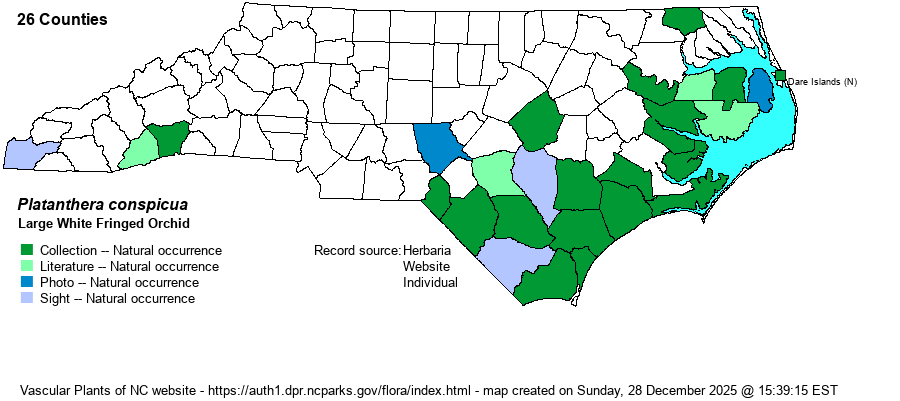| Section 5 » Family Orchidaceae |
Show/Hide Synonym
| taxonName | relationship | relatedTaxonName | relatedTaxonRefText | relComments |
|---|
|
| Platanthera conspicua | = | Platanthera blephariglottis var. conspicua | Flora of North America (1993b, 1997, 2000, 2002a, 2002b, 2003a, 2004b, 2005, 2006a, 2006b, 2006c, 2007a, 2009, 2010) | | | Platanthera conspicua | = | Platanthera blephariglottis var. conspicua | | | | Platanthera conspicua | = | Platanthera blephariglottis var. conspicua | | | | Platanthera conspicua | = | Platanthera blephariglottis var. conspicua | Wunderlin & Hansen Flora of Florida (3) | | | Platanthera conspicua | = | Platanthera blephariglottis var. conspicua | Brown (2002)=Z. | | | Platanthera conspicua | < | Habenaria blephariglottis var. blephariglottis | Radford, Ahles, and Bell (1968) | | | Platanthera conspicua | < | Habenaria blephariglottis var. blephariglottis | Brown (2002)=Z. | | | Platanthera conspicua | = | Habenaria blephariglottis var. conspicua | Gleason and Cronquist (1991) | | | Platanthera conspicua | = | Habenaria blephariglottis var. conspicua | Fernald (1950) | | | Platanthera conspicua | < | Habenaria blephariglottis | Godfrey and Wooten (1979, 1981) | | | Platanthera conspicua | = | Blephariglottis conspicua | Small (1933, 1938) | | | Source: Weakley's Flora |
|
| Author | (Nash) P.M. Brown | |
| Distribution | This taxon is a recent split from Platanthera blephariglottis. Most references list it as a variety, but Weakley (2018) and a few others give it full species status. Though many herbaria do now have specimens labeled as P. conspicua, what percentage of the specimens labeled as P. blephariglottis are really P. conspicua, as opposed to the new taxon of that name? Here we map only specimens that have been annotated by experts. In general, this is the more widespread of the two White Fringed Orchid taxa in NC, occurring mainly across the southern half of the Coastal Plain. It is scattered northward to the VA line, and there are a few occurrences in the southern Mountains. In the Sandhills region, the strict sense P. blephariglottis is supposedly the form found there, according to the map in the revision paper. However, some plants there exhibit spurs intermediate in length and thus suggest P. conspicua - see image below from Moore County - but additional study is needed.
This is the southern taxon/species of the White Fringed Orchid group, ranging north only to eastern NC, south to southern FL, and west barely to eastern TX. There are a few occurrences into the mountains and Piedmont, but it is essentially a Coastal Plain species (as are many members of the genus).
| |
| Abundance | Generally uncommon (to locally fairly common in well-managed preserves) in the southern half of the Coastal Plain, but rare and quite local in the northern half of that province. Rare to perhaps locally uncommon in parts of the Sandhills, but as P. blephariglottis also grows there, the abundances of the two there are not settled. Extremely rare in the southern Mountains. As with most orchids of savanna habitats, it is declining owing to fire suppression and loss of habitat. The NCNHP added this species to its Watch List (W7) in late 2022. Their State Rank of S2S4 indicates uncertainty about the identification of this form from the very similar P. blephariglottis, which were both contained within this latter name until recently. The website editors suggest a State Rank of S3?. | |
| Habitat | This is a species of savannas and wet flatwoods, but it can occur in ditches and a few other disturbed damp but sunny sites. It is also found in streamhead pocosin ecotones and seepages. |
| Phenology | Blooms mostly in August and September in NC, somewhat later than P. blephariglottis where both occur together. Fruits somewhat soon after flowering. | |
| Identification | This is one of the more spectacular wildflowers of the NC Coastal Plain, being easily spotted from long distances across a savanna when in full bloom. Plants grow mostly to 2-2.5 feet tall, with several strongly ascending and shiny leaves emerging from the lower part of the stem. As with all other members of the genus, you must see it in bloom for identification. This taxon, the taller and larger-flowered of the two White Fringed Orchids, has a conical and somewhat open inflorescence of several dozen large white flowers; the flower cluster is typically 4-6 inches tall. The lip projects forward and has fairly long and delicate fringes, and the long spur averages 1.5-2 inches long. The very similar P. blephariglottis,, with which it was recently split, has a shorter and denser inflorescence, a flower lip that has denser fringes, and flower spurs often less than 1 inch long. | |
| Taxonomic Comments | This taxon was formerly included within P. blephariglottis (broad sense) until recently. Many references, including Flora of North America, list it only as a variety -- P. blephariglottis var. conspicua -- whereas Weakley (2018) and a few others have raised it to full species status. Note that nearly all NC Platanthera species were formerly within the genus Habenaria.
| |
| Other Common Name(s) | White Fringed Orchid (now used for the combined two taxa). As these are split out, a modifier name is needed, and thus this is typically named as Large White Fringed Orchid and P. blephariglottis (strict sense) as Small White Fringed Orchid. Southern White Fringed Orchid is another common name. | |
| State Rank | S2S4 [S3?] | |
| Global Rank | G5T4 [G4] | |
| State Status | W7 | |
| US Status | | |
| USACE-agcp | FACW link |
| USACE-emp | FACW link |

